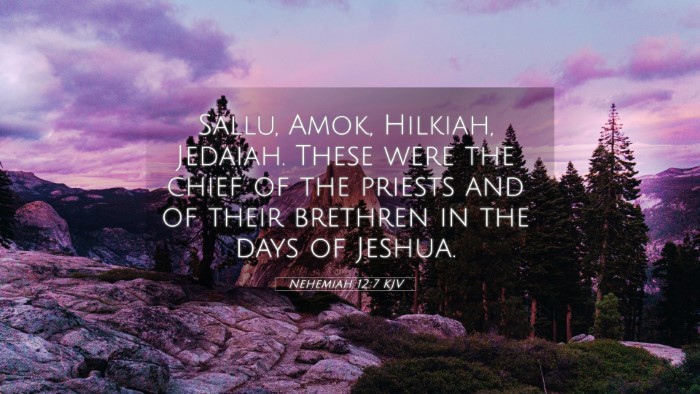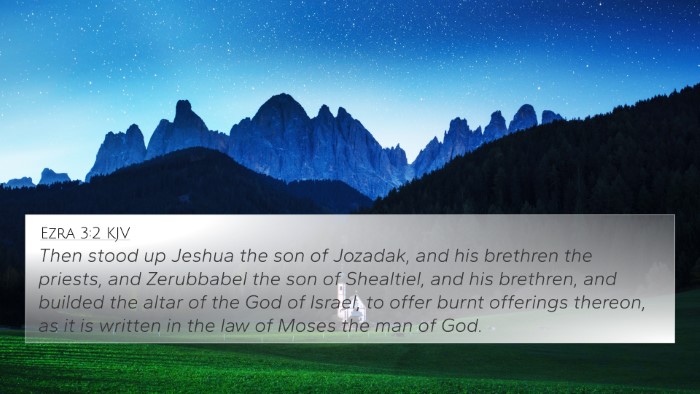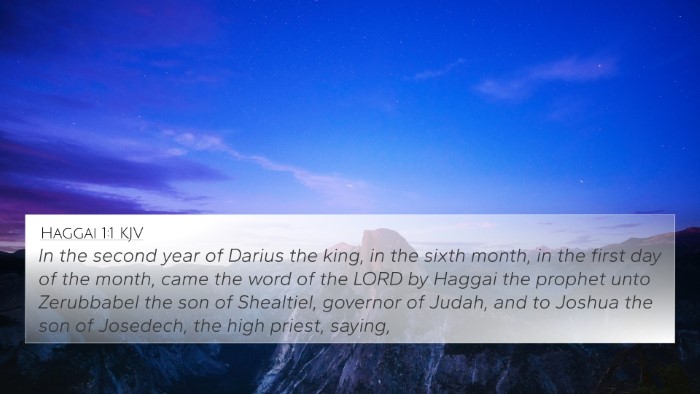Nehemiah 12:7 states: "These are the days of the priests and the Levites that went up with Zerubbabel the son of Shealtiel, and Jeshua the son of Jozadak." This verse is pivotal in providing insight into the restoration of God's people and their worship practices after the Babylonian exile. Below is a detailed exploration of its meaning and its connections to other Scriptures.
Understanding Nehemiah 12:7
This verse is part of a genealogical record that establishes the line of priests and Levites who returned to Jerusalem. The emphasis on names signifies the importance of heritage and continuity in worship and service to God. Here, Nehemiah emphasizes the roles of these individuals in restoring and upholding the covenant practices of Israel.
Commentary Insights
Combining insights from public domain commentaries:
- Matthew Henry: Henry highlights the significance of the return of these leaders as essential for rebuilding both the physical city and the spiritual life of the people. The mention of Zerubbabel and Jeshua represents the political and spiritual leadership needed during this time of restoration.
- Albert Barnes: Barnes provides context, noting that these names connect the returning exiles with their predecessors, emphasizing God’s faithfulness in preserving a remnant of His people. The restoration of the priestly line is crucial for the reestablishment of temple worship.
- Adam Clarke: Clarke points out the implications of priestly service and the Levites' roles in facilitating worship. The careful recording of names illustrates God's meticulous plan for His people and the importance of order in worship.
Cross-Referencing Nehemiah 12:7
Nehemiah 12:7 serves as a hub for several cross-references in the Bible, shedding light on the continuity of God's plan and the importance of leadership in His community. Below are key Bible verses connected thematically:
- Ezra 3:2: Discusses the leadership of Jeshua, tying back to the establishment of worship in Jerusalem.
- Haggai 1:1: Connects to the leaders of the returning exiles, emphasizing their roles in rebuilding the temple.
- Zechariah 3:1-10: Features Jeshua the High Priest in a vision, reaffirming the significance of the priestly lineage.
- Malachi 2:4-7: Speaks about the covenant with Levi, highlighting the responsibilities of priests.
- Hebrews 7:14: References the lineage of priests showing Jesus as a High Priest in a different order, establishing a deeper understanding of priesthood.
- Ezra 2:2: Lists the same leaders, illustrating the continuity and fulfillment of God’s promise in returning the exiles.
- 1 Chronicles 6:4-15: Provides genealogical records of the priests, emphasizing the historical and spiritual significance of their lineage.
- Nehemiah 10:28-29: Further details the commitments made by the returned exiles, including the leadership of priests and Levites.
- Acts 4:36: References a Levite named Barnabas, indicating the ongoing role of Levites in the New Testament church.
- Jeremiah 3:15: Promises to give shepherds after God's own heart, which highlights the ongoing theme of spiritual leadership.
Thematic Connections in Scripture
Nehemiah 12:7 exemplifies a broader theme found throughout Scripture regarding leadership, restoration, and the importance of worship. Each cross-reference provides a conduit for deeper understanding and encourages a comparative study to explore how the Old Testament teachings inform the New Testament context.
Why Cross-Referencing Matters
Cross-referencing Scriptures enhances the understanding of biblical themes, facilitates deeper study, and reveals interconnectedness within the biblical narrative. Tools for Bible cross-referencing include:
- Bible concordance for locating key verses.
- Utilizing a cross-reference Bible study guide to explore relationships between texts.
- Methods for identifying themes across both Old and New Testaments.
- Reviewing Bible reference resources to find thematic connections easily.
- Engaging in comprehensive Bible cross-reference materials for enriched biblical study.
Conclusion
Through this examination of Nehemiah 12:7 and its related verses, readers can develop a robust framework for understanding the significance of ascending leaders during the restoration period. These verses not only illustrate the historical context but also provide themes relevant to all believers, encouraging further exploration of connections within the Scriptures.







